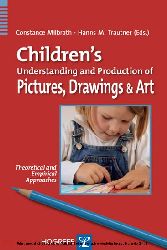Suchen und Finden
About the Editors
7
Contributors
8
Table of Contents
10
Preface
12
Part I Introduction
14
1 Children’s Knowledge About Pictures, Drawing, and Art
16
Introduction
16
Cognition and drawing
17
Metacognition, theory of mind, and children’s understanding and production of pictures, drawing and art
21
The contents of this book
23
Part II General Foundations
32
2 The Origins and Development of Pictorial Symbol Functioning
34
Introduction
34
Outline of the model
35
Foundations for symbolic understanding
38
Achieving representational insight
39
Conceptualizing the symbolic function
40
Conclusions
41
3 Pictorial Competence Generated from Crosstalk Between Core Domains
46
Four ingredients of pictorial competence
47
Pictorial expertise considered as mastery over a domain of knowledge
50
What is the reason for engaging with the pictorial domain?
52
Where children’s minds come into the picture
56
Evidence on cross-domain components of young children’s grasp of depiction
59
Taking a perspective and drawing the threads together
61
4 Memory Components and Control Processes in Children’s Drawing
66
Domain-specific and general components of cognition
66
The emergence of drawing
71
Graphic schemes
80
How children's limited processing capacity affects drawing
84
The mystery of narrative drawing
87
Conclusion
94
Part III Understanding and Developing Pictorial Competence
100
5 Size and Contour as Crucial Parameters in Children Drawing Images
102
Conceptualizing empty space and apparent dissolving of the object
103
Drawing systems
107
Drawing contours
109
Drawing size
112
The power balance of objects and space
115
6 Children’s Choice of Color to Depict Metaphorical and Affective Information
120
Introduction
120
Children’s color use in relation to affect- eliciting topics
121
Future research questions
128
Conclusions
130
7 Children’s Drawing of Friendship and Family Relationships in Different Cultures
134
Introduction
134
The importance of interpersonal relationships
135
Why and how to assess the representation of interpersonal relationships
136
Theoretical perspectives on the drawings of relationships
137
What of a social relationship can we see in a drawing?
139
Drawing and children’s relationships across cultures
147
Conclusions
159
8 Developing Children’s Appreciation of Photographs as Informative and Aesthetic Artifacts
168
Photographs: What and why?
168
Seeing the photographic surface
171
Illustrative empirical work
176
Concluding comments
194
Part IV Developing a Theory of Pictures and Aesthetic Preferences
198
9 Children’s Understanding of Artist- Picture Relations: Implications for Their Theories of Pictures
200
Introduction
200
Infants: action-based knowledge of intentions
203
Toddlers: perceptually-based knowledge of symbol- referent links
206
School age children: conceptually-based understanding of the symbolic function
212
Conclusions
215
10 The Relationship Between Production and Comprehension of Representational Drawing
220
Introduction
220
Development of children’s production and comprehension of pictures
221
Children’s understanding of what develops and why in children’s drawings
237
Interpretations and future directions
241
Summary
245
11 Children’s Developing Understanding and Evaluation of Aesthetic Properties of Drawings and Art Work
250
Models of aesthetic development
251
Properties of drawings and paintings used for classification and evaluation
255
Concluding remarks
268
12 Developmental Preferences and Strategies for Visual Balance in Aesthetic Compositions
274
Visual balance and the development of perceptual capacities
275
Children’s aesthetic appreciation of pictures
278
Children’s ability to produce aesthetic pictures
280
The composition studies
286
Conclusions
300
13 Drawing and Aesthetic Judgments Across Cultures: Diverse Pathways to Graphic Development
306
Background
306
Models of graphic development
308
Previous studies that examine the U-curve claim
311
The three-country study (Kindler, Pariser, and van den Berg, 2000)
314
Conclusions
326
Part V Conclusion
332
14 Future Directions in Studying Children’s Understanding and Production of Pictures, Drawings, and Art
334
Theories of children’s understanding of pictures and the relation between picture, artist, viewer, and world
335
Children’s competence and their production of pictures
337
Children’s comprehension of pictures and its relationship to production
339
Children’s evaluation of aesthetic and expressive properties of pictures
341
Universal and cultural influences on children’s drawings
344
Concluding remarks
346
Subject Index
350
Alle Preise verstehen sich inklusive der gesetzlichen MwSt.









